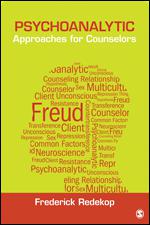 Psychoanalytic Approaches for Counselors is a contemporary look at the work of Sigmund Freud, with the goal of recognizing its historical and cultural context and identifying its value for the 21st century. Redekop begins the book’s introduction by writing, “I am not interested in converting anyone to Freudianism or glorifying Freud as a genius. As the title of this book suggests, my aim is to make psychoanalysis . . . useful for counselors and counselors-in-training.” Redekop acknowledges that many people think of Freud mainly as a cold, distant therapist who chalked all human experience up to sexual and aggressive urges and spent his professional life creating scandalous theories like the Oedipus complex. Redekop paints a more nuanced portrait of Sigmund Freud that also includes elements of warmth, energy, compassion and common sense, and explores valuable Freudian insights that the modern counselor may have overlooked.
Psychoanalytic Approaches for Counselors is a contemporary look at the work of Sigmund Freud, with the goal of recognizing its historical and cultural context and identifying its value for the 21st century. Redekop begins the book’s introduction by writing, “I am not interested in converting anyone to Freudianism or glorifying Freud as a genius. As the title of this book suggests, my aim is to make psychoanalysis . . . useful for counselors and counselors-in-training.” Redekop acknowledges that many people think of Freud mainly as a cold, distant therapist who chalked all human experience up to sexual and aggressive urges and spent his professional life creating scandalous theories like the Oedipus complex. Redekop paints a more nuanced portrait of Sigmund Freud that also includes elements of warmth, energy, compassion and common sense, and explores valuable Freudian insights that the modern counselor may have overlooked.
Redekop offers a great deal of detailed information in Psychoanalytic Approaches for Counselors. He begins with an introduction, providing context for the practices of counseling and psychoanalysis and how they overlap. Chapter 1 provides a brief history of “the talking cure,” including catharsis, hypnotism and the first psychoanalytic patient, who was in fact not a patient of Freud’s at all. Chapters 2 and 3 provide a comprehensive yet accessible overview of psychoanalytic theory, from the id, ego and superego to therapy as a corrective experience. Perhaps one of the most valuable aspects of Psychoanalytic Approaches for Counselors is Chapter 4, which situates the genesis of psychoanalysis in the racist, sexist and sexually repressive context of Europe in the late 19th and early 20th centuries. It is crucial for a student of any theory to be aware of the cultural context that produced it, and Redekop provides that information around Freudianism. Chapter 5 is a detailed and compelling case illustration of modern psychoanalytic work with a client, and the final chapter offers concluding thoughts on Freud’s contemporary relevance.
Psychoanalytic Approaches for Counselors has a number of significant strengths in addition to those already described. The writing style is quite accessible; the text reads more like an enjoyable nonfiction book than a textbook. The author includes frequent vignettes from his own clinical experience, which beautifully illustrate his points. In addition, the chapter-long case study is particularly valuable in demonstrating the contemporary relevance of psychoanalytic theory and practice. However, in addition to these positive aspects, the book also has some limitations. The author makes a few sweeping statements that deserve closer scrutiny, such as his suggestion that eye movement desensitization reprogramming (EMDR) may be merely the latest evolution of hypnotism, and that its success may result mostly from the influence of practitioners’ belief in its strength. Another limitation is the use of some outdated sources; in the section on sexual trauma, Redekop offers the results of a 21-year-old study as context. Although these aspects of the book are somewhat lacking, Psychoanalytic Approaches for Counselors is still a very worthwhile text for counselors and other mental health practitioners to ponder.
Psychoanalytic Approaches for Counselors makes a strong case for the continued relevance of components of psychoanalytic theory. Redekop notes that Freud cared a great deal about his patients and their relationship with him, elements that counselors today refer to as unconditional positive regard and the therapeutic alliance. Taking a fresh look at Freud is a worthwhile endeavor for counselors, who may be surprised at what they find.
Redekop, F. (2015). Psychoanalytic approaches for counselors. Thousand Oaks, CA: Sage.
Reviewed by: Carie McElveen, NCC, the National Board for Certified Counselors, Greensboro, NC.
The Professional Counselor
